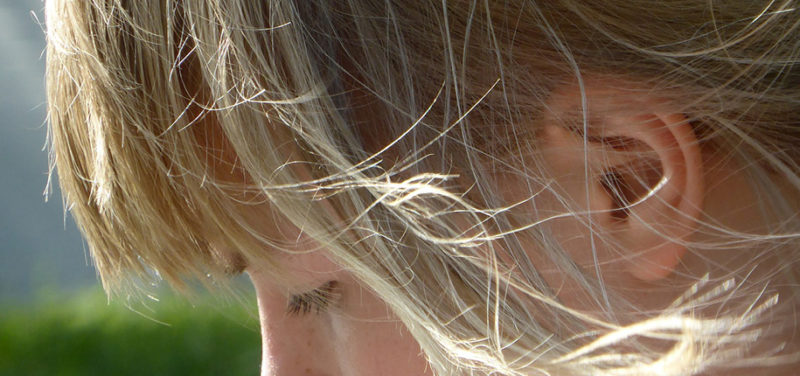
CT and MR imaging are important in your child’s evaluation for sensorineural hearing loss. There are many reasons that a child could have hearing loss, and this specialized imaging helps visualize the small structures of the inner ear and the 8th cranial nerve. This nerve, called the vestibulocochlear nerve, sends information from the inner ear to your child’s brain. The cochlear part of the nerve is primarily involved with hearing, while the vestibular part of the nerve impacts balance. Both exams provide important information to help your child’s ENT doctor create the best plan of care.
CT imaging provides high-resolution pictures of the bony structures of the middle and inner ear. These structures are only a millimeter to a few millimeters in size, but they are essential for hearing. The CT image below demonstrates a normal cochlea (red arrows). This snail-shaped structure helps translate sounds into nerve impulses to send to the brain. The semicircular canals (blue arrows) are three fluid-filled tubes that help with balance and equilibrium. Some of the tiniest bones in the body, called ossicles, (green arrows) are found in the middle ear. They transmit sounds from outside of the ear to the inner ear cochlea. If your child is being evaluated for hearing loss, a CT scan of the structures of the temporal bone may be an important part of the plan of care. CT imaging can be completed quickly, but it is important that your child hold still for the pictures. Some children are able to cooperate while others may need sedation or general anesthesia.
MR imaging is used to demonstrate the actual vestibulocochlear nerve and to define the small, fluid-filled structures that are present in the inner ear. Inner ear abnormalities or even absence of the actual nerves can be seen with MR imaging and help diagnosis potential causes of a child’s hearing loss. The MR image below shows the 8th cranial nerve (CN8) with the cochlear division (red arrows) extending to the cochlea, as well as a portion of the vestibular division (blue arrows) of the nerve as they move through the internal auditory canal. These nerves are often only a millimeter thick, and although they are very small, are necessary for the normal hearing, balance, and health of a child.
MRI also provides a more thorough evaluation of the brain, which might be abnormal and contributing to hearing loss. MR imaging may take 45 minutes to an hour to complete and requires children to be very still. Frequently, infants and young children will need sedation or general anesthesia to complete this important MRI.
Contributed by Dr. Marguerite Caré and edited by Catherine Leopard (CLS).